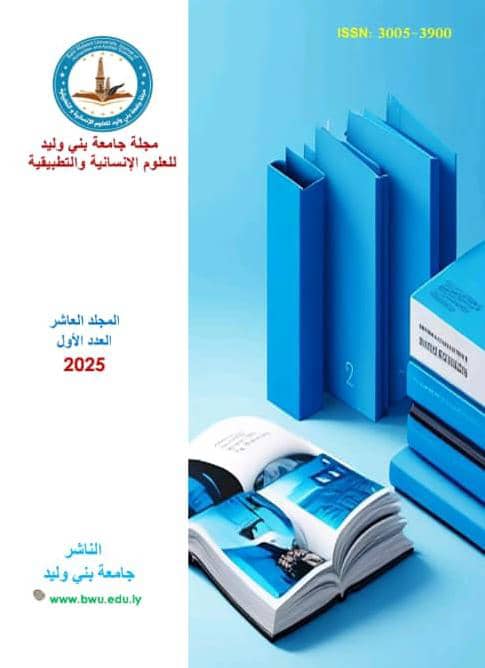Monitoring of Carbamate and Synthetic Pyrethroids pesticides in ground water at East Libya
DOI:
https://doi.org/10.58916/jhas.v10i1.656Keywords:
pesticide residues - carbamates - carbaryl - industrial pyrethroids - groundwater - eastern Libya.Abstract
Groundwater is a vital resource for agriculture in Libya, providing irrigation water for crops and drinking water for communities. However, sustainable and traditional agriculture in Libya can contribute to groundwater pollution through the use of fertilizers, pesticides, and animal waste. This research evaluated pollution and monitored residues of commonly used carbamate and pyrethroid pesticides( (oxamyl, bendiocarb, carbofuran, Carbaryl, thiocarb, permethrin, deltamethrin, and cypermethrin) in Eastern Libya across seven regions. Residues were estimated using High-Performance Liquid Chromatography (HPLC), and the solid-phase extraction (SPE) method was employed. The risks posed by these pesticides were discussed, highlighting their potential effects on human health. and the environment. The assessment results showed that the detection limits ranged from 0.009 to 0.017 mg/L, with recovery rates between 75-90% and relative standard deviation ranging from 15-25%. Of the analyzed samples, 83.31% were found to be free of the tested pesticides, while 16.7% were contaminated. Furthermore, 4.16% of the total samples had residue levels above the maximum residual concentrations limits(MCL), with carbaryl residues exceeding the risk threshold in the Jards and Massa regions at average concentrations of 0.03 ppm and 0.02 ppm, respectively. The results indicated that surface water was more polluted than groundwater wells. It was confirmed that consumers of surface water in the eastern region, particularly in Jards and Massa, are exposed to concentrations of pesticides that could lead to chronic diseases associated with the presence of carbaryl.
Based on the study findings, there is a need to monitor pesticide residues from all groups in water to protect the final consumer from the unregulated use of pesticides. Additionally, there should be future long-term studies to gain deeper insights into the compliance of water in Libya with health standards concerning pesticide use and their presence in water sources.
Downloads
References
Al-Hashemi, Intisar Omar (2016): Social and Economic Dimensions of Hepatitis in Al-Zawiya Region-Libya (A Study in Medical Geography) Journal of Scientific Research in Arts 17: (4) 1-20
Hossam Hassan Abdel-Aali. (2013). Effect of soil cover, irrigation level and nitrogen fertilization on dry weight and nitrogen absorption. Kufa Journal for Agricultural Sciences, 5(1).
Raqiya Murshid Hamid. (2009). Factors affecting industrial pollution. Diyala Journal of Humanities
Miller, L. P., Miknis, R. A., & Flory, G. A. (2021). Guidelines on the management of animal carcasses disposal: for effective disposal of animal carcasses and contaminated materials on small and medium-sized farms (Vol. 23). Food & Agriculture Org. 1(40).
Akintuyi, O. B. (2024a). The Role of Artificial Intelligence in U.S. Agriculture: A Review: Assessing advancements, challenges, and the potential impact on food production and sustainability. Open Access Research Journal of Engineering and Technology, 6(02), 023–032
Akintuyi, O. B. (2024b). AI in agriculture: A comparative review of developments in the USA and Africa. Research Journal of Science and Engineering, 10(02), 060–070.
Alamanos, A., Rolston, A., & Papaioannou, G. (2021). Development of a decision support system for sustainable environmental management and stakeholder engagement. Hydrology, 8(1), 40.
Angbo Epouse Yapo K. M. A., Gono K. N., Sagou D., Cisse C. M., 2020.- Contribution to the evaluation of the exposure of market gardeners in Abidjan district and agricultural workers in an agro-industrial oil palm company to four organophosphate pesticides. World Journal of Pharmacy and Pharmaceutical Sciences, 9(2): 1397-1403.
Aturamu, O. A., Thompson, O. A., & Akintuyi, B. O. (2021). Forecasting the effect of climate variability on yam yield in rainforest and Guinea Savannah agro-ecological zone of Nigeria. Journal of Global Agriculture and Ecology, 11(4), 1-12.
Bingyang, Wang., Donghui, Chen., Xiao, Hui, Weng., Zhiyong, Chang. (2023). Development an electronic nose to recognize pesticides in groundwater. Talanta, doi: 10.1016/j.talanta.2023.125506
Charan, P., S. Ali, Y. Kachhawa, and K. Sharma. 2010. Monitoring of pesticide residues in farmgate vegetables of central Aravalli region of western India. American-Eurasian Journal of Agricultural & Environmental Science 7: 255-258.
Davis, A. M., Webster, A. J., Fitch, P., Fielke, S., Taylor, B. M., Morris, S., & Thorburn, P. J. (2021). The changing face of science communication, technology, extension and improved decision-making at the farm-water quality interface. Marine Pollution Bulletin, 169, 112534.
Dolan, J. W. 2009. Calibration curves, part II: What are the Limits? how are the signal-to-noise ratio and imprecision related? LC-GC North America 27: 306-310.
EL Roby, Salah. M. H.; EL Awamy, Ifdil O. and Ahlam F. Soliman (2015): Monitoring of some carbamate and pyrethroids pesticide residues in certain vegetables in eastern area of Libya Minia conference Agriculture and irrigation March 2015 DOI: 10.13140/RG.2.1.3634.0885
EL Roby, SMH ; EL Awamy, IO; Solyman,AF.(2015) : Monitoring of some carbamate and synthetic pyrethroid pesticides in certain fruits in eastern area of Libya. Fifth International Conference of Plant Protectionm Res. Institute Hurghada- Egypt 3-6 May 2015. DOI 10.13140/RG.2.1.3109.8006.
FAO-WHO. International Code of Conduct on Pesticide Management. Guidelines on Highly Hazardous Pesticides; Food and Agriculture Organization of the United Nations: Rome, Italy, 2016; ISBN 9789251091876.
Feleke,K.S., Seifu, A., Tilahun., Petra, S., Getachew, A., Tammo, S., S. (2022). Pesticide Contamination of Surface and Groundwater in an Ethiopian Highlands’ Watershed. Water, 14(21):3446-3446. doi: 10.3390/w14213446
Gustafson, D. I. (1993). Pesticides in drinking water (pp. xii+-241).
Hoffmann, J., Isaías,.lia, Villela, Toledo, Ferreira., Renata, Welter, Martins., Milena, Santiago, Chiquim., Aline, Raquel, Müller, Tones., Jonas, Simon, Dugatto., Liziara, da, Costa, Cabrera., Alcione, Aparecida, de, Almeida, Alves. (2024). Interrelationships of construction aspects of groundwater catchment wells for human consumption and pollution by multiresidues of pesticides. Caderno Pedagógico, 21(2):e2780-e2780. doi: 10.54033/cadpedv21n2-066
Javaid, Z., G., Muhammad, I., Abid, M., A., Ahsan, B. (2023). Pesticide Contamination of Potable Water and Its Correlation with Water Quality in Different Regions of Punjab, Pakistan. Water, doi: 10.3390/w15030543
Júnior, Isaías, Hoffmann., Júlia, Villela, Toledo, Ferreira., Renata, Welter, Martins., Milena, Santiago, Chiquim., Aline, Raquel, Müller, Tones., Jonas, Simon, Dugatto., Liziara, da, Costa, Cabrera., Alcione, Aparecida, de, Almeida, Alves. (2024). Interrelationships of construction aspects of groundwater catchment wells for human consumption and pollution by multiresidues of pesticides. Caderno Pedagógico, 21(2):e2780-e2780. doi: 10.54033/cadpedv21n2-066
Karasali Helen, Anna Marousopoulou, Kyriaki Machera,2016: Pesticide residue concentration in soil following conventional and Low-Input Crop Management in a Mediterranean agro-ecosystem, in Central Greece, Science of The Total Environment, Volume 541, 15 January 2016, Pages 130-142
Kumari, B., V. Madan, and T. Kathpal. 2006. Monitoring of pesticide residues in fruits. Environmental Monitoring and Assessment 123: 407-412.
Kupa E., Uwaga, Monica, Adanma., Emmanuel, Olurotimi, Ogunbiyi., Nicky, Solomon. (2024). Groundwater quality and agricultural contamination: A multidisciplinary assessment of risk and mitigation strategies. World Journal Of Advanced Research and Reviews, 22(2):1772-1784. doi: 10.30574/wjarr.2024.22.2.1607
Malla, Muneer, Ahmad, Shruti, Gupta., Anamika, Dubey., Ashwani, Kumar., Shweta, Yadav. (2021). Contamination of groundwater resources by pesticides. 99-107. doi: 10.1016/B978-0-12-824058-8.00023-2
Mambe-Ani P., Ouattara K. N., Elleingand F. E., Kadjo V., 2019.- Assessment of the impact of pesticide use in urban and periurban agriculture in Abidjan, Côte d'Ivoire. International Journal of Biology and Chemical Sciences, 13(6): 2824-2837.
Michel Amandine, Dominic Armbruster, Angelika Benz-Birck, Nina Deppermann,Reinhard Doetzer,Markus Flörs,Markus Frericks,Shang-Shih Li,Sebastian Gebler,Tom Schröder,(2022): Proposal for a tiered approach to evaluate the risk of transformation products formed from pesticide residues during drinking water treatment. Environmental Sciences Europe Vol. 34, Iss: 1, pp 1-22
Mohamed, Ahlam, S. I.; Moussa, A.A and Hussein, S.M (2014):Residues of organophosphorus pesticides residues and certain heavy metals in organic and Non-organic tomatoes cultivation in El-Beida region second conference of analatical chemistry in Omar Al Moktar Univ. EL Beida libya May 2014.in press DOI: 10.13140/RG.2.1.5177.7686
Ochulor, O. J., Sofoluwe, O. O., Ukato, A., & Jambol, D. D. (2024). Challenges and strategic solutions in commissioning and start-up of subsea production systems. Magna Scientia Advanced Research and Reviews, 11(1), 031-039
Prost, R.; Yaron, B. 2001.Use of Modified Clays for Controlling Soil Environmental Quality Soil Science, 166, 880.
Shan, Liu., Jisha, Yan., Bowen, Xu., Xinyi, Huang., Haixiong, Qin., Jiayuan, Zhao., Chen, Xia., Shen, Yan., Gang, Liu. (2024). Fates and models for exposure pathways of pyrethroid pesticide residues: A review.. Ecotoxicology and Environmental Safety, 277:116342-116342. doi: 10.1016/j.ecoenv.2024.116342
Shan, Liu., Jisha, Yan., Bowen, Xu., Xinyi, Huang., Haixiong, Qin., Jiayuan, Zhao., Chen, Xia., Shen, Yan., Gang, Liu. (2024). Fates and models for exposure pathways of pyrethroid pesticide residues: A review.. Ecotoxicology and Environmental Safety, 277:116342-116342. doi: 10.1016/j.ecoenv.2024.116342
Sishu F., K.,S., Seifu, A., Tilahun., Petra, Schmitter., Getachew, Assefa., Tammo, S., Steenhuis. (2022). Pesticide Contamination of Surface and Groundwater in an Ethiopian Highlands’ Watershed. Water, 14(21):3446-3446. doi: 10.3390/w14213446
Solymos, E. M.; G. Karoly . (2001) Comparison of extraction methods to monitor pesticide residue in surface water. Journal of Chromotographic Science Vol: 39, Agust (2001).
Spongberg, A.L. and J.M. Martin-Hayden. Pesticide stratification in an engineered wetland delta. Environmental Science and Technology, v.31, no.11, pp. 3161–3165, November 1997.
Wahab, S. et al. 2022. Advancement and new trends in analysis of pesticide residues in food: A comprehensive review. Plants 11: 1106.
Wang Yan Zhang, Jian, Guoping Wang, Chuanyu Gao, Yan Yan, Bolong Wen (2015), Optimization Of Derivatization Procedure And Gas Chromatography–Mass Spectrometry Method For Determination Of Bensulfuron-Methyl Herbicide Residues In Water Journal Of Chromatography B, Volumes 995–996, 2015, Pages 31-37
Wang, J. H., Zhang, Y. B., Chu, X. G., & Wang, X. L. (2006). Determination of pesticide residues in concentrated fruit and vegetable juices by gas chromatography–mass spectrometry with large-volume, temperature-programmed injection. Journal of Instrumental Analysis, 25(2), 29–34
Wen-jun Gui, Jie Tian, Chun-xia Tian, Shu-ying Li, You-ning Ma, Guo-nian Zhu, Ultra performance liquid chromatography-tandem mass spectrometry for the determination of amicarthiazol residues in soil and water samples, Journal of Chromatography B, Volume 972, 1 December 2014, Pages 102-110 .
Van de Zande, J.C., H.A.J. Porskamp, J.M.G.P. Michielsen, H. J. Holterman, J.M.F. Huijsmans. 2000 .Classification of spray applications for drift ability, to protect surface water. Asp. Appl. Biol. 57:57–64
Zhang, S., Z. He, M. Zeng, and J. Chen. 2023. Impact of matrix species and mass spectrometry on matrix effects in multi-residue pesticide analysis based on QuEChERS-LC-MS. Foods 12













